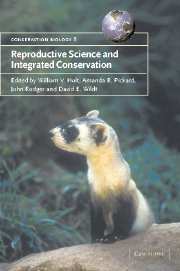Book contents
- Frontmatter
- Contents
- List of contributors
- Foreword
- Part I Introduction
- Part II Reproduction and population viability
- Part III Reproductive techniques for conservation management
- Part IV Integrated conservation management
- Part V Reproduction science in non-mammalian species
- 21 Reproductive technologies and challenges in avian conservation and management
- 22 Reptile reproduction and endocrinology
- 23 Reproductive research and the worldwide amphibian extinction crisis
- 24 Reproduction in fishes in relation to conservation
- Part VI Conclusions
- Index
- References
24 - Reproduction in fishes in relation to conservation
Published online by Cambridge University Press: 21 January 2010
- Frontmatter
- Contents
- List of contributors
- Foreword
- Part I Introduction
- Part II Reproduction and population viability
- Part III Reproductive techniques for conservation management
- Part IV Integrated conservation management
- Part V Reproduction science in non-mammalian species
- 21 Reproductive technologies and challenges in avian conservation and management
- 22 Reptile reproduction and endocrinology
- 23 Reproductive research and the worldwide amphibian extinction crisis
- 24 Reproduction in fishes in relation to conservation
- Part VI Conclusions
- Index
- References
Summary
INTRODUCTION AND BACKGROUND
Human interest in fishes and their reproduction has long been supremely practical. Archaeological studies from Neolithic ‘kitchen middens’ of Denmark (c. 9000–6000 BC) provide evidence of a marine capture fishery for herring, cod, flounder and eel (Travis Jenkins, 1927). It is likely that such pre-agricultural ‘stone age’ humans trapped fishes inshore and on rivers, including populations migrating for spawning. Such practices continue today, including indigenous communities in West Africa using woven fences to trap migrant fishes (Teugels et al., 1992).
Farming freshwater fishes in ponds for food dates from c. 4500 years ago in Sumeria, ancient Egypt, Assyria and China, with evidence that artificial hatching was practised latterly (Hickling, 1971). Basic fish culture existed in the Roman Empire (Higginbotham, 1997), and holding or ‘stew’ ponds for bream and perch are well known from mediaeval Europe, with proper fish farming established between AD 1400 and 1500 (Hickling, 1971). Carp (Cyprinus carpio) and goldfish (Carrassius auratus) were first bred ornamentally in Korea and China (c. 960 BC) and Japan (c. AD 1500) where artificial selection was used to produce aesthetically pleasing coloured varieties.
The practical benefits of fish reproduction attracted early scholars such as Fan Lai (c. 475 BC) and Aristotle (c. 340 BC). A utilitarian, ethnocentric approach to fish reproduction persists today and dominates scientific studies. The main thrust of modern aquaculture is towards improved utilisation of fish (or their gametes – milt, roe, caviar) for food, products or sport fishing.
- Type
- Chapter
- Information
- Reproductive Science and Integrated Conservation , pp. 375 - 394Publisher: Cambridge University PressPrint publication year: 2002



